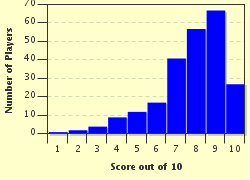Quiz Answer Key and Fun Facts
1. While Pakistan can be translated as 'Land of the Pure', the origins of the name lie in an acronym describing the regions that became the Dominion of Pakistan in 1947. From which neighboring country, also part of the British Raj, did it separate?
2. This image shows Pakistan's official national place of worship. Given that this is an Islamic state, you should be able to select its name from this list. Which of these is it?
3. This picture, taken in 1878, shows a British army column heading to battle during the Second Afghan War. They are about to enter the famous pass that connects Pakistan and Afghanistan. What is its name?
4. This image shows the tomb of Shah Rukn-e-Alam in Multan, which is considered to be the best example still standing of which of these four traditional periods of Pakistani architecture?
5. While you are in Lahore, you might want to visit the tomb of Muhammad Iqbal, whose birthday is a public holiday in Pakistan. For what is he famous?
6. Given the passion that Pakistanis show for their cricket (including the burning in effigy of a losing captain on several occasions!), it may surprise you to learn that which of these is the national sport of Pakistan?
7. The traditional clothing for both men and women in Pakistan is called 'shalwar kameez'. What is the literal meaning of these two words when translated into English?
8. Part of the preparation for a traditional wedding in Pakistan is the mehndi - application of temporary tattoos to the bride (and often to the rest of the bridal party). What is used for these decorative patterns?
9. If you attend a performance of the traditional Punjabi musical form known as Qawwali, you are likely to see the performance accompanied by a drummer. Which of these types of drum is he most likely to be playing?
10. The national animal of Pakistan is the markhor, Capra falconeri, shown here. What kind of ruminant is the markhor?
Source: Author
looney_tunes
This quiz was reviewed by FunTrivia editor
Pagiedamon before going online.
Any errors found in FunTrivia content are routinely corrected through our feedback system.

